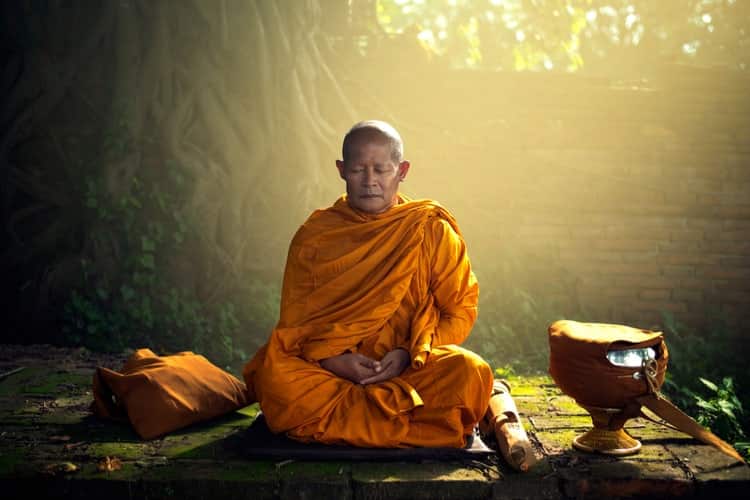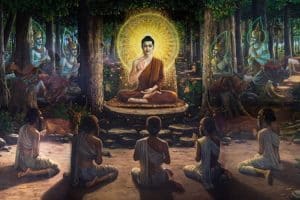We often translate Dharma as the teachings or doctrines of the Buddha. In reality, Dharma signifies what the Buddha became enlightened about, comprehended, and fully understood at the time of his enlightenment.
Dharma also means what the Buddha taught to sentient beings. Therefore, Dharma is not just what we find in texts but also what a meditator experiences during meditation practice. In other words, Dharma signifies the Path, the Fruit, Nirvana, and the teachings of the Buddha. There are the Four Paths, Four Stages, Nirvana, and the teachings of the Buddha.
Thus, when we speak of Dharma, we refer to these ten aspects. The word Dharma has many meanings and is a term that is difficult to translate comprehensively to cover all aspects of Dharma. Therefore, depending on the context and the scripture, we understand the word Dharma in the specific sense relevant to each case or scripture.
When we say Buddha, Dharma, and Sangha, the term Dharma here means the Path, the Stages, Nirvana, and the teachings of the Buddha. In other words, Dharma is what the Buddha realized upon enlightenment and what he taught to the world.
The scriptures record that the Buddha taught rapidly. Today, many people also speak fast; though they speak quickly, we can understand them. In the forty-five years of his teaching, the Buddha gave numerous discourses. The essential points of his teachings alone comprise forty volumes, each several hundred pages long—a vast amount!
Seeing the immense volume of the Dharma that the Buddha taught, we might think it impossible to grasp fully. However, once the Buddha summarized his teachings in a single verse. I believe we should be familiar with this verse. Many of you here might know what this verse is like. This simple verse encapsulates all the Buddha’s teachings:
“Not to do any evil, To cultivate good, To purify one’s mind, This is the teaching of all Buddhas.”
LotusBuddhas are known about Dharma through two scriptures: “One who sees dependent origination sees the Dharma. One who sees the Dharma sees dependent origination (Majjhima Nikaya, number 28, Mahàhatthipadopama sutta). And “One who sees Dharma sees the Buddha; One who sees the Buddha sees Dharma” (Samyutta Nikàya).
So, what does Dharma refer to in these scriptures? In this article, we will explore the true meaning of Dharma, its role within the Three Jewels, and how to practice it in daily life.
Meaning of the Dharma in Religions

Dharma (or Dhamma in Pali), derived from the Sanskrit root dhṛ, meaning ‘to hold or maintain,’ is a multifaceted term that possesses considerable significance in several South Asian religious traditions, including Hinduism, Buddhism, Jainism and Sikhism. The complexity of its interpretations and applications often makes it elusive to exact translation, but it can be generally understood in the context of moral, ethical, and religious obligations, law, truth, justice and righteousness.
In Hinduism: Dharma assumes paramount importance, shaping individual behavior and social institutions. It is seen as an inherent nature of reality, which governs the moral and ethical conduct necessary to maintain harmony within the individual, society and the cosmos. The concept of svadharma, or individual duty, is embedded within this understanding, stipulating that each individual has unique responsibilities based on their age, occupation, gender, and caste, as reflected in the classical literature like the Manusmṛiti and the Mahabharata.
In Buddhism: Dharma (often spelled Dhamma in Pali) signifies both the teachings of the Buddha and the truth or law of nature that these teachings express. It encapsulates the Buddha’s Four Noble Truths, the Eightfold Path, and other elements of Buddhist philosophy and ethics, forming the basis for understanding and liberation from suffering (dukkha).
In Jainism: Dharma is perceived as the moral virtue that must be followed for spiritual liberation. Interestingly, it also represents the medium allowing beings to move in the cosmos, manifesting the tradition’s dual-aspect ontology, which is integral to Jain metaphysics.
In Sikhism: Dharma is integrated into the concept of ‘Dharam’, a moral and righteous path that Sikhs are encouraged to follow, incorporating honest living, selfless service and remembrance of God.
Dhamma encompasses everything in our lives, whether we like it or not, whether we desire it or not, regardless of our expectations. Sudden illness, the breakdown of a relationship, bankruptcy, or unexpected death… all of these are manifestations of Dhamma in this sense. – LotusBuddhas.
While Dharma is contextually dependent, it universally signals towards a system of righteous living, a guide to ethical and moral duties, and a path to spiritual progression and enlightenment. The full extent of Dhamma’s meaning is inevitably nuanced and multi-layered, reflective of the rich and diverse religious traditions in which it is grounded.
Meaning of the Dharma in Buddhism
Dharma (Pāli: Dhamma, Sanskrit: Dharma) is a crucial term in Buddhism. Dharma has many meanings, depending on the context, it can have different interpretations.
According to the Fo Guang Dictionary, Dharma means “All physical phenomena are called form dharma, non-physical are called mind dharma, the changeable is called existent dharma, the unchangeable is called non-existent dharma. The dharmas of form, mind, existent, and non-existent are collectively referred to as the Dharma realm.”
In Yogācāra Buddhism, Dharma encompasses all things and phenomena – whether concrete or abstract – that have their own nature, an intrinsic characteristic that forms a basis, a pattern that allows for recognition and understanding (self-nature, the basis of phenomena interpretation).
Similarly, according to the Great Dictionary of Buddhist Studies by Đinh Phúc Bảo, Dharma means “Everything that has its characteristics – not to be confused with something else – has its own frameworks to generate in our minds a concept about it.”
According to the Tue Quang Buddhist Dictionary, Dharma has key meanings such as:
- Laws, customs, habits, standards of behavior, duties, responsibilities, rules in society…
- Good deeds, virtuous acts, morality.
- The object of mind (dharma realm).
- The Buddha’s teachings including the Sutras, Vinaya, and Abhidharma.
- Truth, ultimate reality, essence, nature.
In the two scriptures mentioned, “Whoever sees dependent origination sees the Dharma; whoever sees the Dharma sees dependent origination” (Majjhima Nikāya, No. 28, The Greater Discourse on the Elephant’s Footprint) and “Whoever sees the Dharma sees the Tathāgata; whoever sees the Tathāgata sees the Dharma” (Saṃyutta Nikāya) do not imply the Buddhist teachings or the scripture (Tripiṭaka) but the ultimate reality itself.
The Buddha’s First Dharma Teaching

The Buddha’s first Dharma teaching, commonly known as the “First Turning of the Wheel of Dharma,” was a pivotal moment in the foundation of Buddhism. This event took place at Deer Park (now Sarnath) near Varanasi in India, where Buddha addressed a group of five ascetics who were his former companions during his austere years of spiritual search.
In this first sermon, the Buddha unveiled the core of his teaching, namely the Four Noble Truths and the Eightfold Path, which continue to form the conceptual backbone of Buddhist thought and practice. This foundational discourse in Buddhist teaching, often referred to as the “Dhammacakkappavattana Sutta” in Pali, essentially set in motion the Wheel of Dhamma.
The Four Noble Truths articulated by the Buddha in this sermon are:
- The Truth of Dukkha (often translated as suffering, dissatisfaction, or unsatisfactoriness): The Buddha expounded that all sentient beings experience suffering in various forms, including the physical and psychological suffering associated with birth, aging, sickness, and death, as well as subtler forms of existential dissatisfaction.
- The Truth of the Origin of Dukkha: This pertains to the causal factors of suffering. The Buddha identified craving (tanhā) as the principal cause of suffering, which manifests in desire for sensual pleasures, desire for becoming and desire for non-becoming.
- The Truth of the Cessation of Dukkha (Nirodha): The Buddha emphasized the possibility of cessation of suffering, or Nibbāna (Nirvana), which denotes the extinguishment of the fires of greed, hatred and delusion.
- The Truth of the Path leading to the Cessation of Dukkha (Magga): This comprises the Noble Eightfold Path that the Buddha presented as a practical guide to end suffering. This path entails right understanding, right intention, right speech, right action, right livelihood, right effort, right mindfulness and right concentration.
In this seminal discourse, the Buddha eschewed two extremes—self-indulgence and self-mortification—and propounded the Middle Way, a path of moderation and mindfulness that leads to insight, wisdom and ultimately to Nibbāna.
It is through this first Dharma teaching that the Buddha initiated his role as a teacher, laying down the philosophical and ethical framework for a path of liberation from suffering, and establishing a tradition that has shaped the lives of millions of people across millennia.
The Six Qualities of the Dharma
The Six Qualities of the Dharma, as outlined in the early Buddhist scriptures, notably in the Anguttara Nikaya 11.12, provide a comprehensive characterization of the nature and value of the Buddha’s teachings. These qualities, which are rendered in Pali language, have profound implications for how the Dhamma should be approached, understood and practiced:
- Svakkhato (Well-expounded): The Dhamma is not a mere speculative philosophy or conjectural theory. It is the Universal Law discovered through the profound enlightenment of the Buddha. The Buddha expounded this Dhamma with utmost precision, clarity and coherence. Its excellence is marked by a tripartite division: it is excellent in the beginning, corresponding to the establishment of sila or moral virtues; it is excellent in the middle, representing the cultivation of samadhi or mental concentration; and it is excellent in the end, culminating in panna or the realization of wisdom.
- Sanditthiko (Evident): The Dhamma is not a set of abstract doctrines to be accepted on faith alone; rather, it is accessible and verifiable by personal practice. It invites empirical investigation and encourages experiential verification. The veracity of the Dhamma can be personally discerned through direct experience, making it immediately evident to those who diligently apply themselves to its practice.
- Akaliko (Timeless): The Dhamma has a timeless quality that is capable of conferring immediate results. It transcends temporal boundaries, making its benefits available in the here and now. This timeless relevance of the Dhamma indicates that there is no necessity to postpone its practice until a future time or future existence. The Dhamma can be practiced, realized and actualized in this very life.
- Ehipassiko (Inviting to Come and See): The Dhamma extends an open invitation to all beings to ‘come and see’ for themselves. It is not restrictive or exclusive, but inclusive and open to scrutiny. It welcomes critical examination and personal experimentation, advocating a path of practice that allows each individual to validate its truth through personal experience.
- Opaneyiko (Leading Inwards): The Dhamma is intrinsically leading inwards, encouraging introspection and self-understanding. It provides a spiritual trajectory that directs the practitioner towards the inner depths of their own mind. This inward orientation of the Dhamma underscores its role as a guide for internal transformation and spiritual development, making it worthy of being integrated into one’s life.
- Paccattam Veditabbo Vinnuhi (To Be Personally Realized by the Wise): The Dhamma can be fully known and perfectly realized only by those who are wise. Specifically, it refers to the noble disciples (ariya puggala) who have attained a degree of spiritual maturity and enlightenment through the cultivation of supreme wisdom (panna). These disciples, through their direct realization of the Dhamma, are able to fully actualize its liberating potential.
The Role of Dharma in the Three Jewels

The “Three Jewels” is a central tenet in Buddhism, encompassing the Buddha (the Enlightened One), the Dharma (the teachings), and the Sangha (the community of practitioners). Collectively, these form the basis of refuge for all Buddhists, a principle that is often publicly affirmed in the act of becoming a Buddhist. Each component plays a crucial role in the path to enlightenment.
The role of the Dharma within the Three Jewels is of paramount importance. Dhamma, signifying the teachings of the Buddha, acts as the guiding principle that provides the framework for understanding the nature of reality and the path towards liberation from suffering (dukkha).
It is through the Dharma that the wisdom and insights of the Buddha are transmitted. The Dharma embodies the Four Noble Truths—the truth of suffering, the origin of suffering, the cessation of suffering, and the path leading to the cessation of suffering. Moreover, it encompasses ethical codes, doctrines, and meditation practices, all of which are integral to the cultivation of wisdom and compassion, the reduction of afflictive states, and ultimately, the attainment of enlightenment.
The Dhamma also provides the doctrinal and ethical foundation for the Sangha. It is the Dharma that the monastic and lay Sangha study, practice and strive to embody in their lives. It provides a common ground and a shared focus that bind together the community of practitioners, fostering mutual support and collective advancement on the path to enlightenment.
The Dharma’s role in the Three Jewels is vital. As the teachings of the Buddha and the guide to practice, the Dharma illuminates the path to liberation and provides the necessary knowledge and methods to walk that path. Without the Dhamma, the wisdom of the Buddha and the practice of the Sangha would be inaccessible. Therefore, the Dharma, together with the Buddha and the Sangha, forms an indispensable part of the refuge in the journey of liberation, as recognized in the Buddhist tradition.
How to Practice the Dharma in Daily Life

Practicing Buddha Dharma in daily life involves incorporating Buddhist principles and teachings into everyday activities. The Dhamma offers not just metaphysical and ethical insights, but also practical guidelines that can be applied to foster mindfulness, compassion, and wisdom, which are integral to leading a life in line with the Dhamma.
Mindfulness and awareness: One of the most essential practices is mindfulness, which involves maintaining a moment-by-moment awareness of our thoughts, feelings, bodily sensations and surrounding environment. This can be cultivated through regular meditation and by staying mindful during everyday activities like eating, walking, or even during work. Such conscious awareness allows individuals to respond to situations mindfully rather than reacting impulsively, reducing afflictive emotions and fostering peace and clarity.
Ethical conduct: Following the Five Precepts or moral guidelines in Buddhism is another way to practice the Dharma. These include abstaining from killing, stealing, sexual misconduct, lying and intoxication. By observing these precepts, individuals cultivate ethical behavior that contributes to their own well-being and that of others, manifesting a fundamental respect for life and personal integrity.
Cultivation of virtues: Buddhism encourages the development of positive qualities such as generosity (dāna), loving-kindness (mettā), compassion (karuṇā), sympathetic joy (mudita) and equanimity (upekkhā). These virtues can be practiced in daily interactions, fostering harmonious relationships and contributing to personal and societal well-being.
Study and reflection: Regular study of Buddhist texts and teachings is essential to deepen understanding of the Dharma. This could include reading sutras, attending Dharma talks, or participating in discussion groups. Reflecting on these teachings and relating them to one’s personal experiences promotes an experiential understanding of the Dhamma.
Community engagement: Engaging with the Sangha or Buddhist community can provide support and inspiration for Dharma practice. This could involve participation in communal rituals, services, retreats, or volunteering for social service projects organized by the Buddhist community.
Right Livelihood: Practicing the Dharma also extends to one’s profession. Choosing a livelihood that aligns with Buddhist ethical principles, that does no harm to others, and that ideally contributes positively to society, is part of living the Dharma.
Contemplation on impermanence: Contemplating the impermanent nature of all phenomena can help individuals maintain a balanced perspective on life’s ups and downs. It reduces attachment to transient pleasures and aversion to difficulties, fostering equanimity and wisdom.
In summary, Dharma or Dhamma refers to the natural laws (truths) that the Buddha realized upon enlightenment and compiled into teachings to help followers gain a deeper understanding of the nature of existence. Through contemplation and the application of Dharma, individuals navigate their journey towards liberation and enlightenment.
What is Dharmakaya?
Dharmakaya, often translated as “Body of Truth” or “Body of Reality,” is a fundamental concept in Mahayana Buddhism and Vajrayana Buddhism, and is part of the trikaya, or “Three Bodies” doctrine, which presents an understanding of the Buddha’s nature and manifestation. The Trikaya doctrine comprises Dharmakaya, Sambhogakaya (Body of Bliss or Enjoyment Body), and Nirmanakaya (Emanation Body or Transformation Body).
Dharmakaya refers to the ultimate, unmanifested, inconceivable aspect of a Buddha, out of which Buddhas arise and into which they return after their dissolution. It represents the unity of all things and beings, unmanifested, beyond existence or nonexistence, beyond concepts.
In essence, Dharmakaya is the embodiment of the ultimate truth, the absolute reality beyond conventional, relative reality. It is often equated with emptiness (Shunyata) or suchness (Tathata) as described in Mahayana sutras, pointing towards the indescribable nature of ultimate reality beyond the limits of conceptualization, language, and duality.
The Dharmakaya is also associated with the Buddha’s omniscience or perfect knowledge, as it is through the Dharmakaya that the Buddha understands the nature of all phenomena. As the fundamental reality of all things, the Dharmakaya is the source from which the wisdom and compassion of all Buddhas emanate.






